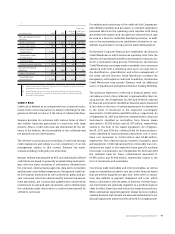Siemens 2015 Annual Report Download - page 96
Download and view the complete annual report
Please find page 96 of the 2015 Siemens annual report below. You can navigate through the pages in the report by either clicking on the pages listed below, or by using the keyword search tool below to find specific information within the annual report.
Consolidated Financial Statements
NOTE 23 Derivative financial instruments
and hedging activities
Fair values of each type of derivative financial instruments
recorded as financial assets or financial liabilities are:
Sep 30, 2015 Sep 30, 2014
(in millions of €) Asset Liability Asset Liability
Foreign currency
exchange contracts 713 1,297 352 901
Interest rate swaps
and combined interest
and currency swaps 1,824 381 1,769 456
Other (embedded
derivatives, options,
commodity swaps) 691 241 448 391
3,228 1,919 2,569 1,749
FOREIGN CURRENCY EXCHANGE RATE
RISK MANAGEMENT
Derivative financial instruments
not designated in a hedging relationship
The Company manages its risks associated with fluctuations in
foreign currency denominated receivables, payables, debt, firm
commitments and forecast transactions primarily through a
Company-wide portfolio approach. Under this approach the
Company-wide risks are aggregated centrally, and various de-
rivative financial instruments, primarily foreign currency ex-
change contracts, foreign currency swaps and options, are uti-
lized to minimize such risks. Such a strategy does not qualify
for hedge accounting treatment. The Company also accounts
for foreign currency derivatives, which are embedded in sale
and purchase contracts.
Cash flow hedges
The Company’s operating units apply hedge accounting for cer-
tain significant forecast transactions and firm commitments
denominated in foreign currencies. Particularly, the Company
has entered into foreign currency exchange contracts to reduce
the risk of variability of future cash flows resulting from fore-
cast sales and purchases as well as firm commitments. This risk
results mainly from contracts denominated in US$ both from
Siemens’ operating units entering into long-term contracts e. g.
project business and from standard product business.
Periods in which the hedged forecast transactions or the firm
commitments denominated in foreign currency are expected to
impact profit or loss:
Fiscal year
2016 2017
2018 to
2020
2021 and
thereafter
(in millions of €)
Expected gain (loss) to be
reclassified from line item
Other comprehensive in-
come, net of income taxes
into revenue or cost of sales (163) (87) (72) 23
INTEREST RATE RISK MANAGEMENT
Derivative financial instruments
not designated in a hedging relationship
For the interest rate risk management relating to the Group ex-
cluding SFS’ business, derivative financial instruments are used
under a portfolio-based approach to manage interest risk ac-
tively relative to a benchmark. The interest rate management
relating to the SFS business remains to be managed separately,
considering the term structure of SFS’ financial assets and lia-
bilities on a portfolio basis. Neither approach qualifies for
hedge accounting treatment. Net cash receipts and payments
in connection with interest rate swap agreements are recorded
as interest expense in Other financial income (expenses), net.
Cash flow hedges of floating-rate
commercial papers
Since fiscal , Siemens applies cash flow hedge accounting
to a revolving portfolio of floating-rate commercial papers of
nominal US$ million. To benefit from low interest rates in
the USA, Siemens pays a fixed rate of interest and receives a
variable rate of interest, offsetting future changes in interest
payments of the underlying floating-rate commercial papers.
Net cash receipts and payments are recorded as interest ex-
penses.
Fair value hedges of fixed-rate debt obligations
Under the interest rate swap agreements outstanding during
the years ended September , and , the Company
has agreed to pay a variable rate of interest multiplied by a no-
tional principle amount, and to receive in return an amount
equal to a specified fixed rate of interest multiplied by the same
notional principal amount. These interest rate swap agree-
ments offset an impact of future changes in interest rates des-
ignated as the hedged risk on the fair value of the underlying
fixed-rate debt obligations. Carrying amount adjustments to
debt for fair value changes attributable to the respective interest
rate risk being hedged are included in Other financial income
























